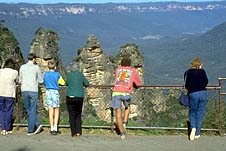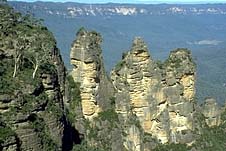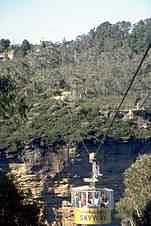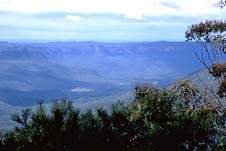
|
| Visitors gaze across at
the Three Sisters |
Katoomba
The principal tourist destination in the Blue Mountains,
offering breathtaking vistas and a rich variety of
accommodation.
For most people Katoomba is the true heart of the Blue
Mountains. When they think of the Blue Mountains they think
of the spectacular views over the Megalong and Jamieson
Valleys, the Three Sisters, huge old hotels like the
Carrington, the famous Paragon Cafe, the Skyway and the
Scenic Railway - all of which can be enjoyed by visitors to
Katoomba. It seems as though Katoomba, located 106
kilometres from Sydney and 1017 metres above sea level, has
a virtual monopoly on the mountains' most famous
attractions.
It is easy to forget, when reflecting on the towns in the
Blue Mountains - Leura, Blackheath, Mount Victoria and so on
- that the only really substantial settlement along the road
and railway line is Katoomba. It is the largest settlement
in the Mountains and is also the administrative centre for
the City of the Blue Mountains. Katoomba is geared for
tourism. It is the central attraction in the mountains.
The area was first explored by Europeans when Blaxland,
Wentworth and Lawson crossed the Blue Mountains in 1813. It
is known they came close to the present townsite as one of
the members of the expedition clearly marked a tree. The
evidence suggests that they camped near the modern-day town
site on 25 May 1813. The town's name reputedly comes from a
local aboriginal word 'godoomba' meaning 'water tumbling
over a hill'.
As early as 1841 George Clarke had discovered coal in the
area (the whole Sydney basin has an underlay of coal which
rises at Newcastle in the north, around Wollongong in the
south and is present at the bottom of the cliffs in the Blue
Mountains) and by 1870 kerosene shale had been discovered in
Kanimbla Valley. A coal mine opened at Katoomba in 1879 and
kerosene shale was being mined by 1885.
The area became hugely popular with the establishment of
a railway station in 1876. It was first called 'Crushers'
but was changed to Katoomba a year later. From this point it
was a popular holiday resort providing excellent
bushwalking, delightful views over the valleys and gracious
hotels.
By 1889 the Illustrated Sydney News was able to describe
Katoomba as 'a town which is practically the outcome of
public appreciation during the past four years. The summit
of one of the highest points about the Blue Mountains is
covered with a cluster of houses, amongst which are many
handsome residences with The Carrington conspicuous in the
centre. Substantial shops line the main street, and
everywhere are evidence of progress and prosperity. Katoomba
is going ahead.'
While it remained the centrepiece of Katoomba, it was
really during the 1920s and 1930s that The Carrington
acquired its reputation. The hotel's visitors included
royalty - the Prince of Wales stayed in 1920 and the Duke
and Duchess of York in 1927. It was during this time that it
became known as the 'Honeymoon Capital of Australia'.
As Katoomba grew as a holiday destination so it's coal
mining fortunes declined. The coal mine closed in the 1920s
although the spectacular railway to the mine has remained
open and is now a popular tourist attraction.
The electrification of the railway line in 1957 can be
seen as the symbolic starting point when the whole of the
Blue Mountains became a commuter zone for Greater Sydney.
Things to see:
![[Top of page]](smlArrow.gif)

|
| The Three Sisters
|
Echo Point
Any visit to Katoomba should start at Echo Point, which is
located at the end of Echo Point Road (an extension of
Lurline St). Not only does it offer superb views but the
Blue Mountains Tourist Centre on the site will provide you
with all the maps and information you can possibly require.
This extraordinary vantage point offers exceptional views of
the Three Sisters, Mount Solitary, the Ruined Castle and the
vast Jamison Valley. An easy 1-km return walk to the Three
Sisters provides outstanding views and is
wheelchair-friendly. Longer walks which start at Echo Point
are the easy Prince Henry Cliff Walk (2 km one way), the
Rainforest Walk/Furber Steps/Scenic Railway Circuit Walk (2
km, medium difficulty), the difficult Giant
Stairway/Dardanelles Pass/Prince Henry Cliff Walk Circuit (5
km), the Giant Stairway/Federal Pass/Scenic Railway Circuit
Walk (5 km, medium difficulty)) and the mostly level Echo
Point/Prince Henry Cliff Walk/Gordon Falls Walk (5 km, one
way). Anyone interested in bushwalking in the Katoomba area
should obtain a copy of 'Bushwalking in the Katoomba Leura
Area' and 'Echo Point & The Three Sisters' (both published
by the National Parks and Wildlife Service). They provides
detailed information about the walks around the cliff tops.
For further information ring the National Parks and Wildlife
Service on (02) 4787 8877.
Katoomba After Dark
Everyone who goes to the mountains should make sure they are
at Katoomba after dark because the Three Sisters, Katoomba
Falls and Leura Cascades are all floodlit.
Echo Point Gallery
The Echo Point Gallery is located at the Three Sisters
Pavilion on Echo Point Rd. Open daily, from 10.00 a.m. to
5.00 p.m., it sells paintings, prints, cards and limited
editions from mountains artists such as Lars Knudsen.
The Carrington Hotel
In his delightfully nostalgic book The Carrington Hotel,
Geoff Bates covers every aspect of the history of the hotel.
He provides a history of how Lord Carrington (1843-1928),
the Governor of New South Wales from 1885-1890, came to the
mountains for weekends at the Great Western Hotel. It was
during one of these visits that the proprietor, F.C. Goyder,
asked permission to change the hotel's name to the
Carrington. Lord Carrington agreed and the change of name
was celebrated with a banquet.
There is perhaps no better way of understanding the charm
and historic importance of Katoomba than an advertisement
for the Carrington Hotel which dates from the late
nineteenth century.
'THE CARRINGTON' KATOOMBA
THE PROPRIETOR of the above Hotel has pleasure in
bringing directly under the notice of visitors to the Blue
Mountains the numerous advantages specially possessed by
Katoomba:‹ The Town is situate 66 miles from Sydney at an
elevation of 3,333 feet, thus ensuring a healthy climate,
and giving the beneficial change of New Zealand or Tasmania,
without the discomforts and dangers of a sea voyage. It is
ABSOLUTELY IN THE CENTRE OF ALL THE FAMED SCENERY of the
District being nine miles from Govett's Leap; five miles
from Wentworth Falls; 1 1/4 miles from Leura Falls (the most
favoured of all Mountain sights); 1 1/2 miles from Katoomba
Falls; three miles from Nelly's Glen. From Katoomba also the
big Zig Zag can be seen during the morning, and the Jenolan
Caves can be visited the trip taking three days.
It is one of the thirteen historic inns listed on the
excellent History Highway Inns website. Check it out at
History Highway Inns which offers detailed information
about the historic inns in the Blue Mountains.
The Paragon Cafe
A walk down Katoomba Street will take the visitor to the
town's other famous, man-made attraction, The Paragon Cafe,
now listed by the National Trust because of its superb 1930s
Art Deco interior. Although other towns throughout Australia
have milk bars from the 1930s this is regarded as a
particularly fine example and the owners are happy to ensure
that the ambience is maintained.
Aboriginal Dreamtime
This Aboriginal owned and operated busines sells indigenous
carvings, paintings, jewellery, didgeridoos and artefacts,
as well as serving Aborigibal dishes such as kangaroo, emu
and crocodile, tel: (02) 4782 9635.
Minnie Ha-Ha Falls
Minnie Ha-Ha Falls are located in a reserve in North
Katoomba at the end of Minnie Ha Ha Rd which runs off South
St.
Katoomba Falls Reserve
West of Katoomba, via Cliff Drive, is Katoomba Falls Reserve
where there is a picnic area. From the kiosk (opposite the
caravan park) visitors can embark on the 1-km Round Walk.
This circuit track offers excellent views, birdlife and lush
rainforest.

|
| The Skyway
|
Scenic Skyway
A little further west, via Cliff Drive, is a signposted
turnoff into Violet Drive which takes visitors to thew cliff
edge where they will find the Scenic Skyway which crosses
the Jamison Valley. This is not for the faint-hearted. The
aerial cable car floats across the valley some 275 metres
above the valley floor and offers views of the Katoomba
Falls and Orphan Rock. The Skyway, the first horizontal
passenger-carrying ropeway in the Southern Hemisphere, was
completed in 1958 and, together with the Scenic Railway, has
become one of Katoomba¹s top tourist attractions. There is
also a restaurant and souvenir shop.
Scenic Railway and Bushwalks
Operating from the same site is the Scenic Railway. It has
its origins in local mining operations which used coal skips
to ferry miners down the cliff face to work. Tourists were
permitted to partake of the thrilling descent by 1930 on
board what is said to be the steepest incline railway in the
world. Today visitors descend 230 metres into the Jamison
Valley via a cable car which carries 80 people and operates
every ten minutes. At the bottom is a 300-metre,
wheelchair-friendly wooden boardwalk which extends into the
rainforest. Part of the journey is a 10-minute slide show on
a large screen at the entrance to the disused coal mines.
From the bottom of the Scenic Railway it is possible to
undertake lengthy, scenic, rainforest bushwalks such as the
Ruined Castle Walk (12 km return, medium difficulty) which
follows the route once used by shale and coal miners, and
the hard-going Furber Steps/Ruined Castle/Golden Stairs Walk
(12 km return).
Gearin's Hotel
Built in 1881 by George Biles, it was bought by a Mrs Gearin
in 1910 and has been known as Gearin's Hotel ever since. It
is now both backpacker and tourist accommodation. It is one
of the thirteen historic inns listed on the excellent
History Highway Inns website. Check it out at
History Highway Inns which offers detailed information
about the historic inns in the Blue Mountains.
Cahill's Lookout
Further west again, along Cliff Drive, is Cahill's Lookout
which offers outstanding views west along the Megalong
Valley. An easy 500-metre return walk traverses the area.
The site is signposted from Cliff Drive.
Narrow Neck
Continue west along Cliff Drive towards Blackheath. A
signposted turnoff on the left lleads to Narrow Neck
Lookout. A difficult 8-km return bushwalk takes in the
Golden Stairs and the Ruined Castle and offers excellent
views.
Explorers Tree and Convict Graves
As one heads west of Katoomba along the Great Western
Highway, en route to
Medlow Bath, the so-called Explorer's Tree (clearly
marked on the main road) can be seen on the left-hand side
of the road, by the turnoff into Pulpit Hill Rd, about 2.5
km west of Katoomba. Pulpit Hill's name derives from the
fact that religious services were held here in the convict
era. Being perfectly honest, it is nothing more than a dead
tree which has been rather preciously preserved under a roof
and surrounded by a fence. The dead tree¹s claim to fame is
that it was inscribed with the initials of Blaxland,
Wentworth and Lawson when they passed by in May 1813. This
is interesting but the stump of the dead tree, without even
a remnant of the famous inscription, is unimpressive.
However, no more than about 100 metres away from the
tree, and signposted with a rather anonymous 'Convicts
Graves' are a collection of six unmarked graves (no names,
just headstones cut out of rock) of convicts who died while
working on the construction of the original Cox¹s Road
across the mountains. It is worthwhile pausing to reflect on
the hardships of these anonymous labourers who died so far
from Britain. It is also worth contemplating how history is
always written by the victors. Surely the graves are far
more interesting and informative than a featureless dead
tree stump?
Bonnie Doon Falls and the Six Foot Track
Just along the aforementioned Pulpit Hll Rd, is a turnoff on
the left into Nellies Glen Rd (unsealed). On the eastern
side of this road are Bonnie Doon Falls. At the point where
Bonnie Doon Falls Road becomes bitumen the precipitous 42-km
Six Foot Walking Track starts. It follows Megalong Creek
south-west into the floor of the Megalong Valley and on to
Jenolan Caves. Overall, this is a hard walk but with
easy sections, especially once down in the valley.

|
| The views across the
Megalong and Jamieson valleys |
Cliff Drive East
Cliff Drive also heads east from Katoomba along the
cliffline to Leura. This road is a highlight of any visit to
the area. The views across the Megalong and Jamison valleys,
the different angles on the Three Sisters, the Ruined Castle
and Mount Solitary, the variety of excellent picnic spots
and the range of lookouts make this a must for anyone
wanting to experience the full beauty of the area. One of
the highlights of Cliff Drive is Leura Cascades. There is a
beautiful picnic area on Chelmsford Drive (which runs off
Cliff Drive) with a 3-km return walk leading to Leura
Cascades, Leura Falls and on into the Leura Forest.

Broadwalk
Business Brokers
Broadwalk Business
Brokers specialise in General Businesses for Sale, Caravan Parks for
Sale, Motels for Sale, Management Rights & Resorts for Sale, Farms for
Sale, Hotels for sale,Commercial & Industrial Properties for Sale.
Phone:
1300 136 559
Email:
enquiries@broadwalkbusinessbrokers.com.au
AUSTRALIAN BUSINESSES FOR SALE
COFFS HARBOUR BUSINESS BROKERS
BROADWALK BUSINESS BROKERS
GOLD COAST BUSINESSES FOR SALE
BRISBANE BUSINESSES FOR SALE
SYDNEY BUSINESSES FOR SALE
CARAVAN PARKS FOR SALE
BUSINESSES FOR SALE
MOTELS
FOR SALE
HOTELS
FOR SALE
Disclaimer
We advise prospective purchasers that we take no
responsibility for the accuracy of any information in the business
provided by vendors or their professional advisers and that they should
make their own enquiries as to the accuracy of this information,
including obtaining independent legal and/or accounting advice
Katoomba

